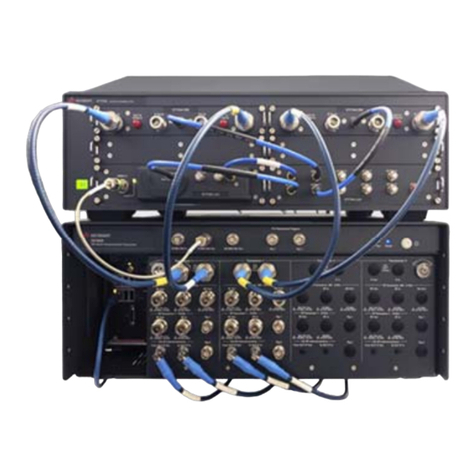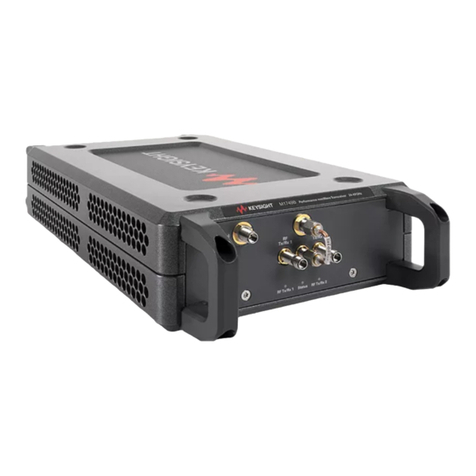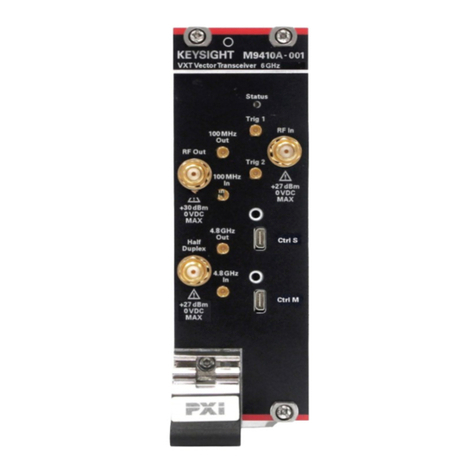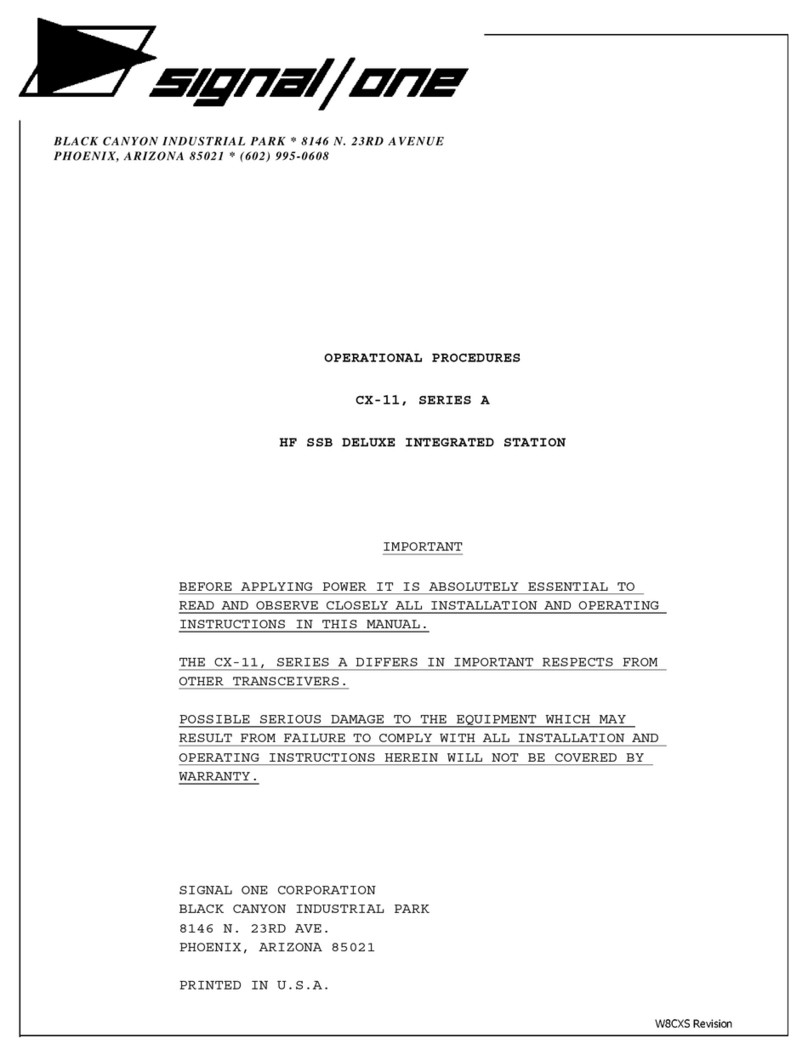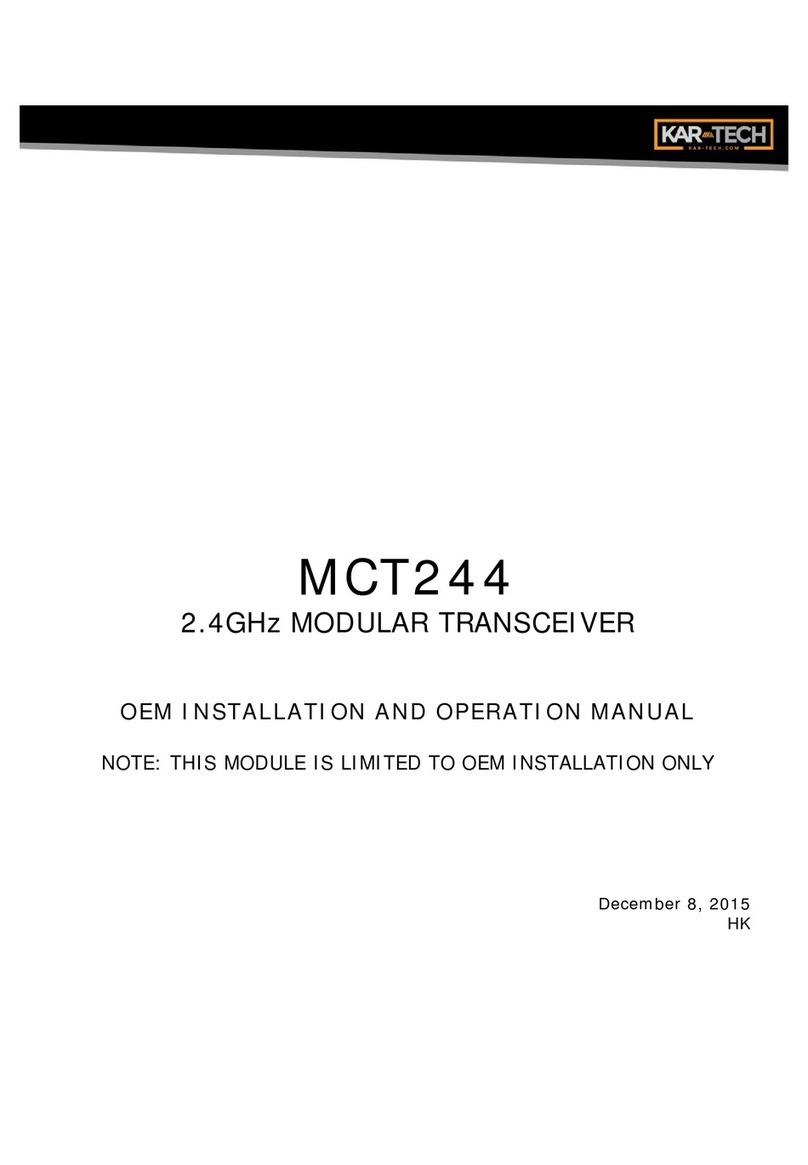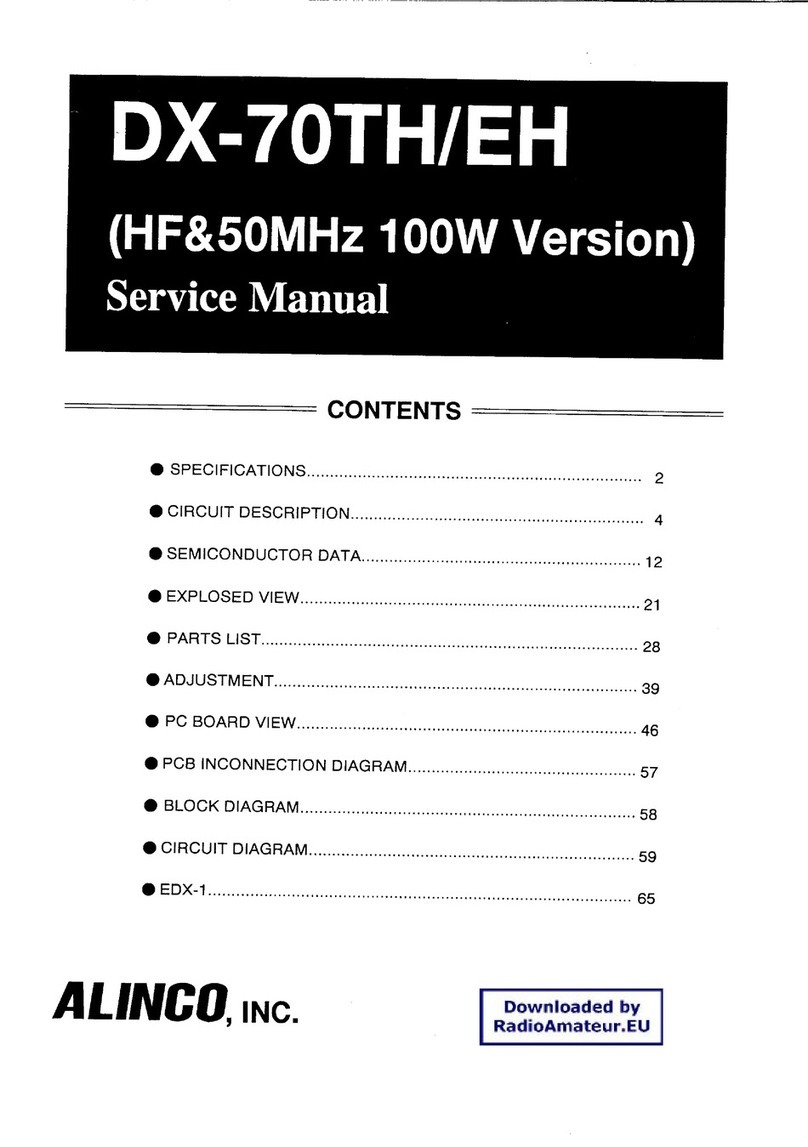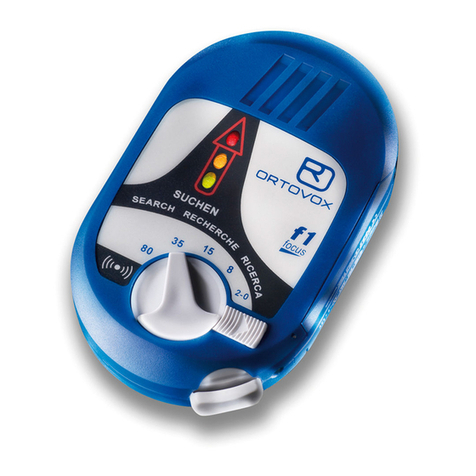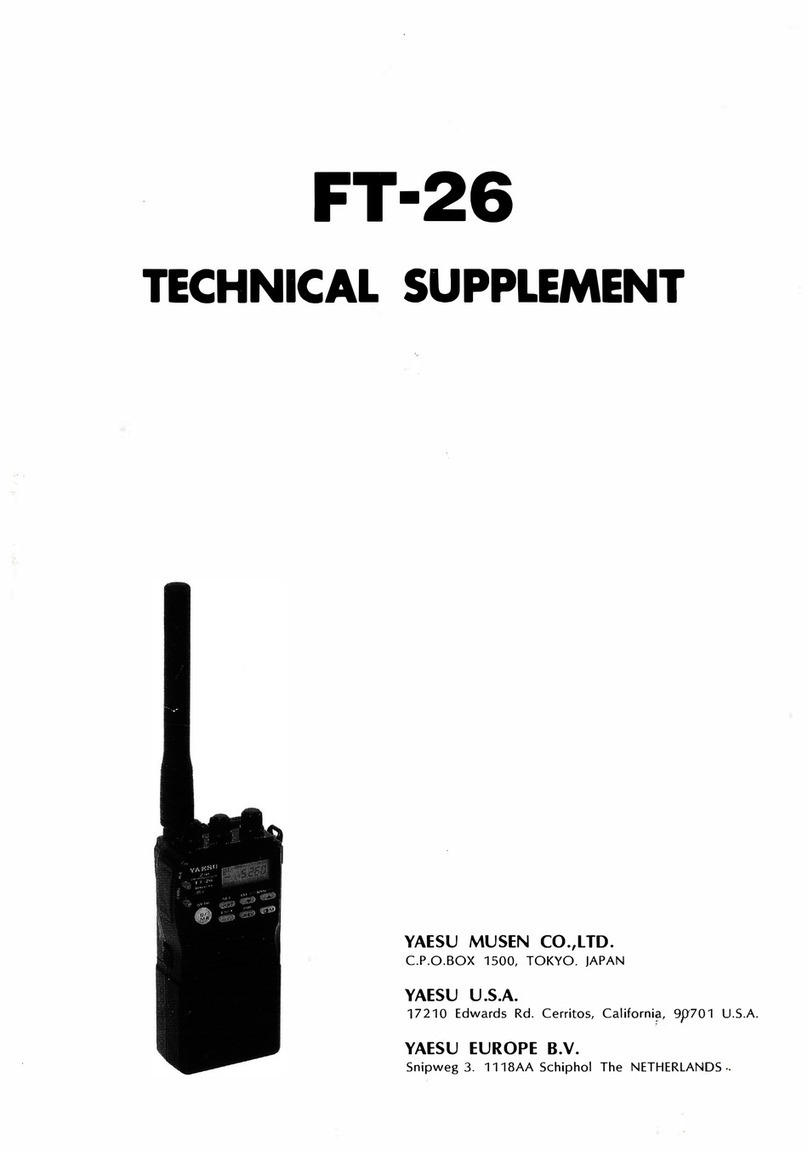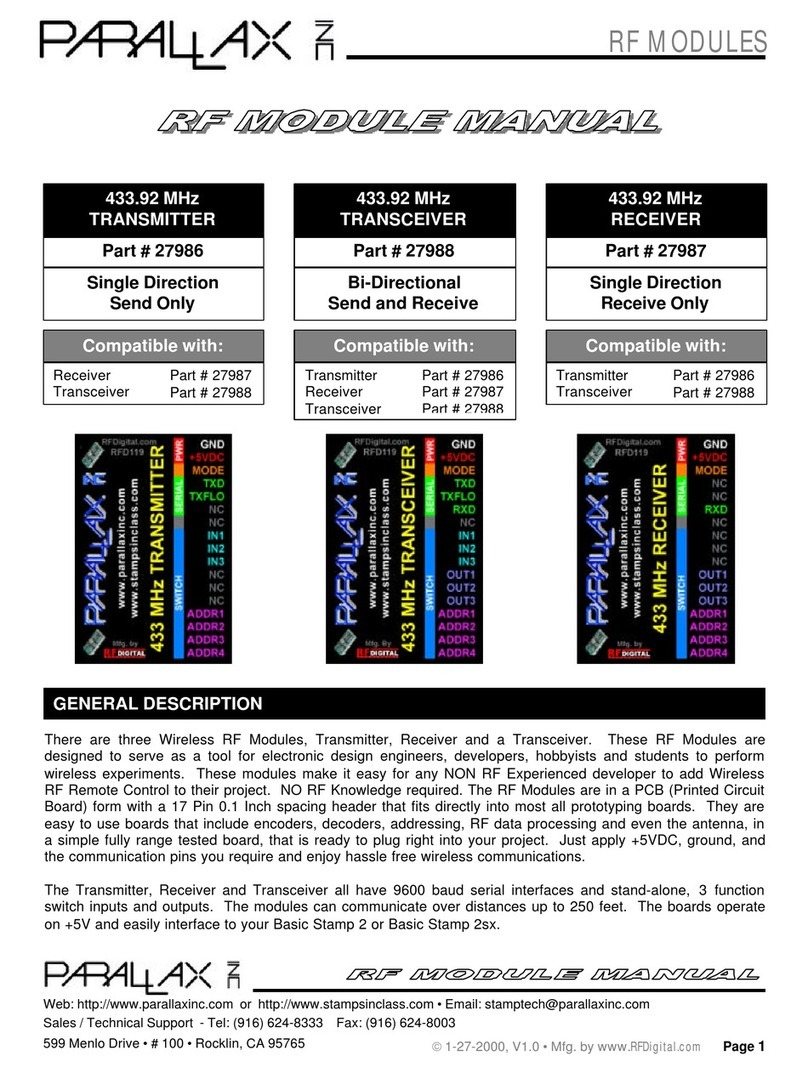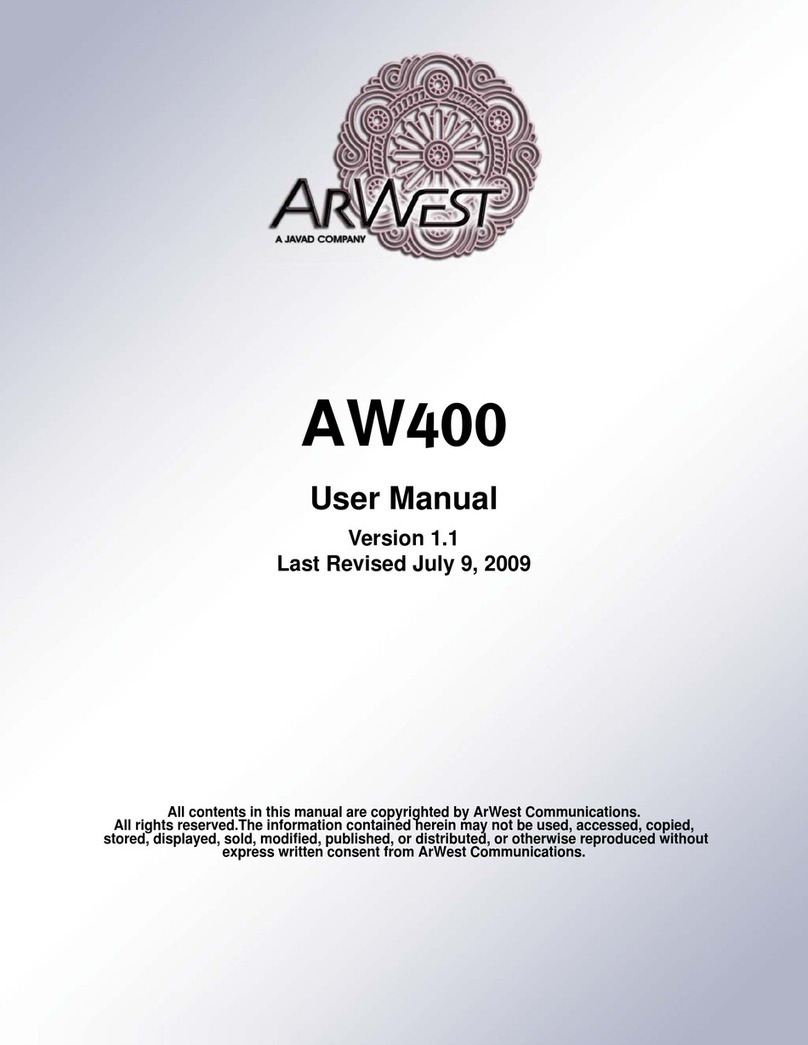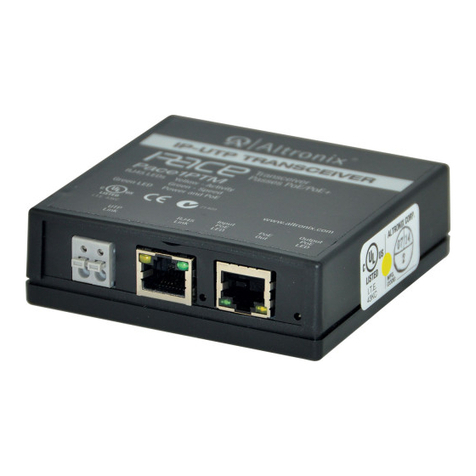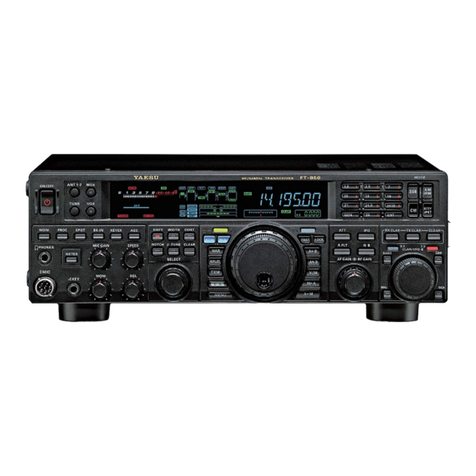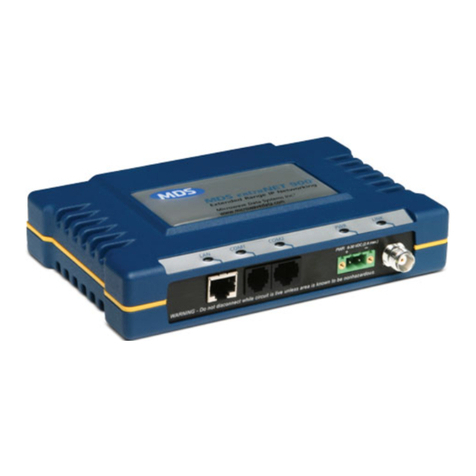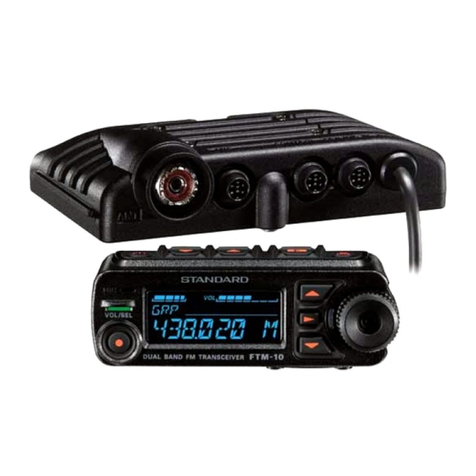Keysight Technologies S9130A User manual

Getting Started
Guide
Keysight mmWave Reference Solutions
S9130A Performance 5G Multi-band
Vector Transceiver

Notices
© Keysight Technologies, Inc. 2020
No part of this manual may be
reproduced in any form or by any
means (including electronic storage
and retrieval or translation into a
foreign language) without prior
agreement and written consent from
Keysight Technologies, Inc. as
governed by United States and
international copyright laws.
Trademark Acknowledgments
Manual Part Number
S9130-90001
Edition
Edition 1, November 2020
Printed in USA/Malaysia
Published by:
Keysight Technologies
1400 Fountaingrove Parkway
Santa Rosa, CA 95403
Warranty
THE MATERIAL CONTAINED IN THIS
DOCUMENT IS PROVIDED “AS IS,”
AND IS SUBJECT TO BEING
CHANGED, WITHOUT NOTICE, IN
FUTURE EDITIONS. FURTHER, TO
THE MAXIMUM EXTENT PERMITTED
BY APPLICABLE LAW, KEYSIGHT
DISCLAIMS ALL WARRANTIES,
EITHER EXPRESS OR IMPLIED WITH
REGARD TO THIS MANUAL AND
ANY INFORMATION CONTAINED
HEREIN, INCLUDING BUT NOT
LIMITED TO THE IMPLIED
WARRANTIES OF
MERCHANTABILITY AND FITNESS
FOR A PARTICULAR PURPOSE.
KEYSIGHT SHALL NOT BE LIABLE
FOR ERRORS OR FOR INCIDENTAL
OR CONSEQUENTIAL DAMAGES IN
CONNECTION WITH THE
FURNISHING, USE, OR
PERFORMANCE OF THIS
DOCUMENT OR ANY INFORMATION
CONTAINED HEREIN. SHOULD
KEYSIGHT AND THE USER HAVE A
SEPARATE WRITTEN AGREEMENT
WITH WARRANTY TERMS
COVERING THE MATERIAL IN THIS
DOCUMENT THAT CONFLICT WITH
THESE TERMS, THE WARRANTY
TERMS IN THE SEPARATE
AGREEMENT WILL CONTROL.
Technology Licenses
The hardware and/or software
described in this document are
furnished under a license and may be
used or copied only in accordance
with the terms of such license.
U.S. Government Rights
The Software is “commercial
computer software,” as defined
by Federal Acquisition Regulation
(“FAR”) 2.101. Pursuant to FAR
12.212 and 27.405-3 and
Department of Defense FAR
Supplement (“DFARS”) 227.7202,
the U.S. government acquires
commercial computer software
under the same terms by which
the software is customarily
provided to the public.
Accordingly, Keysight provides
the Software to U.S. government
customers under its standard
commercial license, which is
embodied in its End User License
Agreement (EULA), a copy of
which can be found at
http://www.keysight.com/find/sweula
The license set forth in the EULA
represents the exclusive authority
by which the U.S. government
may use, modify, distribute, or
disclose the Software. The EULA
and the license set forth therein,
does not require or permit,
among other things, that
Keysight: (1) Furnish technical
information related to
commercial computer software
or commercial computer
software documentation that is
not customarily provided to the
public; or (2) Relinquish to, or
otherwise provide, the
government rights in excess of
these rights customarily provided
to the public to use, modify,
reproduce, release, perform,
display, or disclose commercial
computer software or
commercial computer software
documentation. No additional
government requirements
beyond those set forth in the
EULA shall apply, except to the
extent that those terms, rights, or
licenses are explicitly required
from all providers of commercial
computer software pursuant to
the FAR and the DFARS and are
set forth specifically in writing
elsewhere in the EULA. Keysight
shall be under no obligation to
update, revise or otherwise
modify the Software. With
respect to any technical data as
defined by FAR 2.101, pursuant
to FAR 12.211 and 27.404.2 and
DFARS 227.7102, the U.S.
government acquires no greater
than Limited Rights as defined in
FAR 27.401 or DFAR 227.7103-5
(c), as applicable in any technical
data.
Safety Notices
A CAUTION notice denotes a hazard. It
calls attention to an operating
procedure, practice, or the like that,
if not correctly performed or adhered
to, could result in damage to the
product or loss of important data. Do
not proceed beyond a CAUTION
notice until the indicated conditions
are fully understood and met.
A WARNING notice denotes a hazard.
It calls attention to an operating
procedure, practice, or the like that,
if not correctly performed or adhered
to, could result in personal injury or
death. Do not proceed beyond a
WARNING notice until the indicated
conditions are fully understood and
met.
A NOTE calls the user’s attention
to an important point or special
information in the text.

3
Where to Find the Latest Information
Documentation is updated periodically. For the latest information about these products, including instrument software
upgrades, application information, and product information, browse to one of the following URLs.
More information about the test set can be found at:
www.keysight.com/find/S9130A
To receive the latest updates by email, subscribe to Keysight Email Updates at:
http://www.keysight.com/find/MyKeysight
Information on preventing instrument damage can be found at:
www.keysight.com/find/PreventingInstrumentRepair
Is your product software up-to-date?
Periodically, Keysight releases software updates to fix known defects and incorporate product enhancements. To search
for software updates for your product, go to the Keysight Technical Support website at:
http://www.keysight.com/find/techsupport

4

Contents
Getting Started Guide 5
Table of Contents
Safety & Environmental Information 9
Elements of the System 10
Warning Statements and Symbols 11
Safety 12
Safety Compliance 12
Safe Installation 12
Acoustic statement (European Machinery Directive) 12
General Safety Notices 12
Environmental Conditions (Operating) 13
Environmental Information 13
EMC (Electromagnetic Compatibility) 14
South Korean Class A EMC declaration 14
Declaration of Conformity 14
Ventilation 15
Power requirements (PXIe subsystem) 16
Power requirements (M1741A) 17
Power specifications of the supplied AC/DC adapter 17
Using Accessories 17
Weight and Dimensions 18
Handling and Lifting 18
Protecting against electrostatic discharge 18
Instrument Maintenance 20
Cleaning the Instrument 20
Cleaning the Connectors 20
Quick Start 21
Initial Inspection 22
Shipping Problems? 23
Purpose and Function 24
Path Switching within the M1741A 26
Use Case: mmWave DUT 27
Use Case: RF/mmWave DUT 28
Use Case: RF DUT 29
Location and Mounting 30
Options and Licenses 31
Hardware Options 31

6 Getting Started Guide
Contents
Application Licenses 32
Exterior Features 35
PXIe Subsystem Front Panel 36
PXIe Subsystem front panel: PXIe Chassis section 37
PXIe Subsystem front panel: Controller section 38
PXIe Subsystem front panel: RF Transceiver section 40
PXIe Subsystem front panel: mmWave Transceiver section 42
M1741A Exterior Panels 44
M1741A, DUT-facing side 44
M1741A, instrument-facing side 46
Labels and Symbols (PXIe Subsystem) 49
Labels and Symbols (M1741A) 51
Cable Connections 53
User Interface 55
Launching the Measurement Software 56
Screen Interface 58
Screen Tabs 60
System Settings 61
Preset 62
Meas Bar 63
Menu Panel 64
Measurement Display 65
Control Bar 66
Minimized window 67
Help System 68
Command Interface 70
Operating Tasks 73
Receiver Setup 74
Source Setup 79
Port Configuration 82
Port selection 83
Configuration examples (RF range only) 86
Configuration example (mmWave range only) 88
Configuration examples (RF and mmWave ranges) 89
Alignments 91
Alignments menu 91
Comparing alignment types 92
Align Now All 94

Contents
Getting Started Guide 7
Align IF Cable 95
Align External Mixer Path 96
Align High Band 97
Align Low Band 98
Align LO Clock Synchronization 98
Align RRH Amplitude 99
Checking Temperature and Status 100
LAN Address Configuration 101
Configuring the LAN 102
Managing Licenses 103
Node-locked License 104
Transportable License 104
USB-Portable License 105
Floating License 106
System Components 107
PXIe Subsystem 108
mmWave Transceiver 109
RF Transceiver 110
Extended System 111
PXIe System Controller 112
Controller documentation 112
Troubleshooting 113
Basic Operational Check 114
Identifying Problems 120
Where to get technical help 121
Returning the S9130A for Service 122
Calling Keysight Technologies 122
Locations for Keysight Technologies 123

8 Getting Started Guide
Contents

9
Keysight Wireless Solutions
S9130A Performance 5G Multi-band Vector Transceiver
Getting Started Guide
1 Safety & Environmental Information
The following topics can be found in this section:
“Elements of the System” on page 10
“Warning Statements and Symbols” on page 11
“Safety” on page 12
“Environmental Conditions (Operating)” on page 13
“EMC (Electromagnetic Compatibility)” on page 14
“Ventilation” on page 15
“Power requirements (PXIe subsystem)” on page 16
“Using Accessories” on page 17
“Weight and Dimensions” on page 18
“Protecting against electrostatic discharge” on page 18
“Instrument Maintenance” on page 20

10 Getting Started Guide
Safety & Environmental Information
Elements of the System
Elements of the System
The three main elements of the S9130A will be referred to in this guide as
follows:
—PXIe Subsystem (all hardware in the enclosed PXIe chassis of instruments)
—M1741A (the M1741A Performance mmWave Transceiver, which is used by
the PXIe Subsystem as a Remote Radio Head to test mmWave devices)
—RF Cable Bundle (a 5-cable assembly designed to connect the PXIe
subsystem with the M1741A)
Figure 1-1 Three main elements of S9130A

Getting Started Guide 11
Safety & Environmental Information
Warning Statements and Symbols
Warning Statements and Symbols
Caution and Warning notices are used in this document are described below.
See also: “Labels and Symbols (PXIe Subsystem)” on page 49.
A CAUTION notice denotes a hazard. It calls attention to an operating
procedure, practice, or the like that, if not correctly performed or adhered to,
could result in damage to the product or loss of important data. Do not proceed
beyond a CAUTION notice until the indicated conditions are fully understood
and met.
A WARNING denotes a hazard. It calls attention to an operating procedure,
practice or the like that, if not correctly performed or adhered to, could result in
personal injury or death. Do not proceed beyond a WARNING notice until the
indicated conditions are fully understood and met.

12 Getting Started Guide
Safety & Environmental Information
Safety
Safety
This product has been designed and tested in accordance with accepted
industry standards, and has been supplied in a safe condition.The
documentation contains information and warnings that must be followed by
the user to ensure safe operation and to maintain the product in a safe
condition.
Safety Compliance
This product complies with the essential requirements of the European Low
Voltage Directive as well as current editions of the following standards (dates
and editions are cited in the Declaration of Conformity):
— IEC/EN 61010-1
— Canada: CSA C22.2 No. 61010-1
— USA: UL std no. 61010-1
Safe Installation
Safety of any system incorporating this equipment is the responsibility of the
assembler of the system.
Acoustic statement (European Machinery Directive)
Acoustic noise emission
LpA <70 dB
Operator position
Normal operation mode per ISO 7779
General Safety Notices
Capable of rendering an electrical shock or burn.
If this product is not used as specified, the protection provided by the
equipment could be impaired. This product must be used in a normal condition
(in which all means for protection are intact) only.
No operator serviceable parts inside. Refer servicing to qualified personnel. To
prevent electrical shock, do not remove covers.

Getting Started Guide 13
Safety & Environmental Information
Environmental Conditions (Operating)
Environmental Conditions (Operating)
This product is designed for use in the following conditions:
— For indoor use only
— Altitude up to 3048 m
— Temperature 20 to 30°C
— Maximum relative humidity 95% (non-condensing)
Environmental Information
Samples of this product have been type tested in accordance with the Keysight
Environmental Test Manual and verified to be robust against the environmental
stresses of Storage, Transportation and End-use; those stresses include but
are not limited to temperature, humidity, shock, vibration, altitude and power
line conditions.
Test Methods are aligned with IEC 60068-2 and levels are similar to
MIL-PRF-28800F Class 3.
This product is designed for use in INSTALLATION CATEGORY II and
POLLUTION DEGREE 2.

14 Getting Started Guide
Safety & Environmental Information
EMC (Electromagnetic Compatibility)
EMC (Electromagnetic Compatibility)
This product complies with the essential requirements of the European
Directive as well as current editions of the following standards (dates and
editions are cited in the Declaration of Conformity):
— IEC/EN 61326-1
— CISPR Pub 11 Group 1, class A
— AS/NZS CISPR 11
— ICES/NMB-001
This ISM device complies with Canadian ICES-001.
Cet appareil ISM est conforme a la norme NMB-001 du Canada.
South Korean Class A EMC declaration
This equipment is Class A suitable for professional use and is for use in
electromagnetic environments outside of the home.
Declaration of Conformity
The Declaration of Conformity for any Keysight product can be found on the
website:
http://www.keysight.com/go/conformity
This equipment is not intended for use in residential environments and may not
provide adequate protection to radio reception is such environments.
This is a sensitive measurement apparatus by design and may have some
performance loss during receive measurements using a low input range setting.
Ambient continuous electromagnetic phenomena between 2.3 and 4.1 GHz may
appear at up to 55 dB above DANL using the M1741A Tx/Rx ports, and such
phenomena between 1 and 4 GHz may appear at up to 60 dB above DANL when
using the RF Input/Output ports.

Getting Started Guide 15
Safety & Environmental Information
Ventilation
Ventilation
VENTILATION REQUIREMENTS: When installing the instrument(s) into a
cabinet, consideration shall be given to the convection flow into and out of the
cabinet. Consideration shall also be given to the individual instruments to avoid
having the heated discharge of one instrument, now becoming the cooling
intake air for another instrument.
Do not place the transceiver against any surface in such a way as to block its
ventilation openings. Interfering with ventilation airflow can cause the
transceiver to overheat.
Another area of concern is verification that the maximum ambient operating
temperature of the instrument(s) is not exceeded by cabinet installation.
Keysight recommends forced air convection whenever an instrument(s) are
installed in a cabinet and further recommends that the maximum operating
temperature of the cabinet be reduced 10°C from the lowest, of the maximum
operating temperature of a single instrument.
If there are any concerns or special requirements an Keysight Field Engineer
should be consulted to assure instrument(s) temperature compliance and
performance.

16 Getting Started Guide
Safety & Environmental Information
Power requirements (PXIe subsystem)
Power requirements (PXIe subsystem)
100/120V, 50/60Hz, 1200W MAX (485W typical)
220/240V, 50/60Hz, 1300W MAX (465W typical)
Install the instrument so that the detachable power cord is readily identifiable
and is easily reached by the operator. The detachable power cord is the
instrument disconnecting device. It disconnects the mains circuits from the
mains supply before other parts of the instrument. The front panel switch is
only a standby switch and is not a LINE switch. Alternatively, an externally
installed switch or circuit breaker (which is readily identifiable and is easily
reached by the operator) may be used as a disconnecting device.
The main power cord is the system disconnecting device. It disconnects the
mains circuits from the mains supply.
The instrument can operate with mains supply fluctuations up to +10% of
nominal.
The Mains wiring and connectors shall be compatible with the connector used
in the premise electrical system. Failure to ensure adequate earth grounding by
not using the correct components may cause product damage and serious
injury.
Use the Keysight-supplied power cord, or one with the same or better electrical
rating.
This is a Safety Protection Class I Product (provided with a protective earthing
ground incorporated in the power cord). The mains plug shall only be inserted in
a socket outlet provided with a protective earth contact. Any interruption of the
protective conductor inside or outside of the product is likely to make the
product dangerous. Intentional interruption is prohibited.
This instrument has auto-ranging line voltage input. Be sure the supply voltage
is within the specified range, and that voltage fluctuations do not to exceed 10
percent of the nominal supply voltage.

Getting Started Guide 17
Safety & Environmental Information
Power requirements (M1741A)
Power requirements (M1741A)
The M1741A does not have an AC power connection. It is powered by a DC
input from an AC/DC converter (19VDC, 6 A). This input does not represent a
risk of personal injury.
Power specifications of the supplied AC/DC adapter
— Input: 100-240VAC, 50-60 Hz, 2.5-1A
— Input power stability: the AC-DC adapter is certified and can operate with
mains supply voltage fluctuations up to ±10% of the nominal voltage.
— Output: 19 VDC, 7.89A
The main power cord is the system disconnecting device. It disconnects the
mains circuits from the mains supply.
Using Accessories
Only Keysight-approved accessories shall be used.
Use the RF Cable Bundle supplied with the system to connect the PXIe
subsystem to the M1741A.
Use the AC-DC power adapter and power cord supplied with the system to
power the M1741A.
See the accessories listed under “Initial Inspection” on page 22.
Do not remove the DC input plug from the M1741A while it is in an active state.
Make sure the Status LED on the DUT-facing side of the M1741A is dark
before disconnecting the DC input.
This is a Safety Protection Class I Product (provided with a protective earthing
ground incorporated in the power cord). The mains plug shall only be inserted in
a socket outlet provided with a protective earth contact. Any interruption of the
protective conductor inside or outside of the product is likely to make the
product dangerous. Intentional interruption is prohibited.
This instrument has auto-ranging line voltage input. Be sure the supply voltage
is within the specified range, and that voltage fluctuations do not to exceed 10
percent of the nominal supply voltage.
Proper ergonomics should be considered when using accessories such as a
keyboard or a mouse.

18 Getting Started Guide
Safety & Environmental Information
Weight and Dimensions
Weight and Dimensions
The weight and dimensions of the PXIe Subsystem are as follows.
— Weight: 22.68 kg
— Height: 197.8 mm
— Width: 449.5 mm
— Length: 568.9mm
The weight and dimensions of the M1741A are as follows.
—Weight:3.5kg
—Height:70mm
— Width: 175 mm
— Length: 345 mm
Handling and Lifting
For best practice and proper ergonomics, the weight of the components makes
it necessary to use caution in handling and lifting:
Protecting against electrostatic discharge
Electrostatic discharge (ESD) can damage or destroy electronic components
(the possibility of unseen damage caused by ESD is present whenever
components are transported, stored, or used).
Test equipment and ESD
To help reduce ESD damage that can occur while using test equipment:
• Before connecting any coaxial cable to a test set connector for the first time
each day, momentarily short the center and outer conductors of the cable
together.
• Personnel should be grounded with a 1 MΩresistor-isolated wrist-strap
before touching the center pin of any connector and before removing any
assembly from the test set.
(1) Two persons are needed to lift and carry the S9130A.
(2) Use both side handles when lifting the S9130A.
(3) Use a rolling cart when transporting the S9130A.
Do not use these first three techniques when working on circuitry with a voltage
potential greater than 500 volts.

Getting Started Guide 19
Safety & Environmental Information
Protecting against electrostatic discharge
• Be sure that all instruments are properly earth-grounded to prevent
build-up of static charge.
• Perform work on all components or assemblies at a static-safe workstation.
• Keep static-generating materials at least one meter away from all
components.
• Store or transport components in static-shielding containers.
• Always handle printed circuit board assemblies by the edges. This reduces
the possibility of ESD damage to components and prevent contamination of
exposed plating.
Additional information about ESD
For more information about ESD and how to prevent ESD damage, contact the
Electrostatic Discharge Association (http://www.esda.org). The ESD standards
developed by this agency are sanctioned by the American National Standards
Institute (ANSI).

20 Getting Started Guide
Safety & Environmental Information
Instrument Maintenance
Instrument Maintenance
Cleaning the Instrument
Cleaning the Connectors
Cleaning connectors with isopropyl alcohol shall only be done with all cables
disconnected, and in a well-ventilated area. Allow all residual alcohol moisture
to evaporate, and the fumes to dissipate prior to energizing the instrument.
Disconnect the instrument from all cables before cleaning. Use a dry cloth or one
slightly dampened with water to clean the external case parts. Do not attempt to
clean internally.
Cleaning connectors with alcohol shall only be done with the instrument's power
cord removed, and in a well-ventilated area. Allow all residual alcohol moisture to
evaporate and the fumes to dissipate prior to energizing the instrument.
Keep isopropyl alcohol away from heat, sparks, and flame. Store in a tightly
closed container. The alcohol shall not be stored, or left open, in the area of the
equipment. Use isopropyl alcohol with adequate ventilation to prevent the
combustions of fumes or vapors.
Avoid contact with eyes, skin, and clothing, as isopropyl alcohol causes skin
irritation, may cause eye damage, and is harmful if swallowed or inhaled. It may
be harmful if absorbed through the skin. Wash thoroughly after handling. In case
of spill, soak up with sand or earth. Flush spill area with water. Dispose of
isopropyl alcohol in accordance with all applicable federal, state, and local
environmental regulations.
In case of fire, use alcohol foam, dry chemical, or carbon dioxide; water may be
ineffective.
Table of contents
Other Keysight Technologies Transceiver manuals
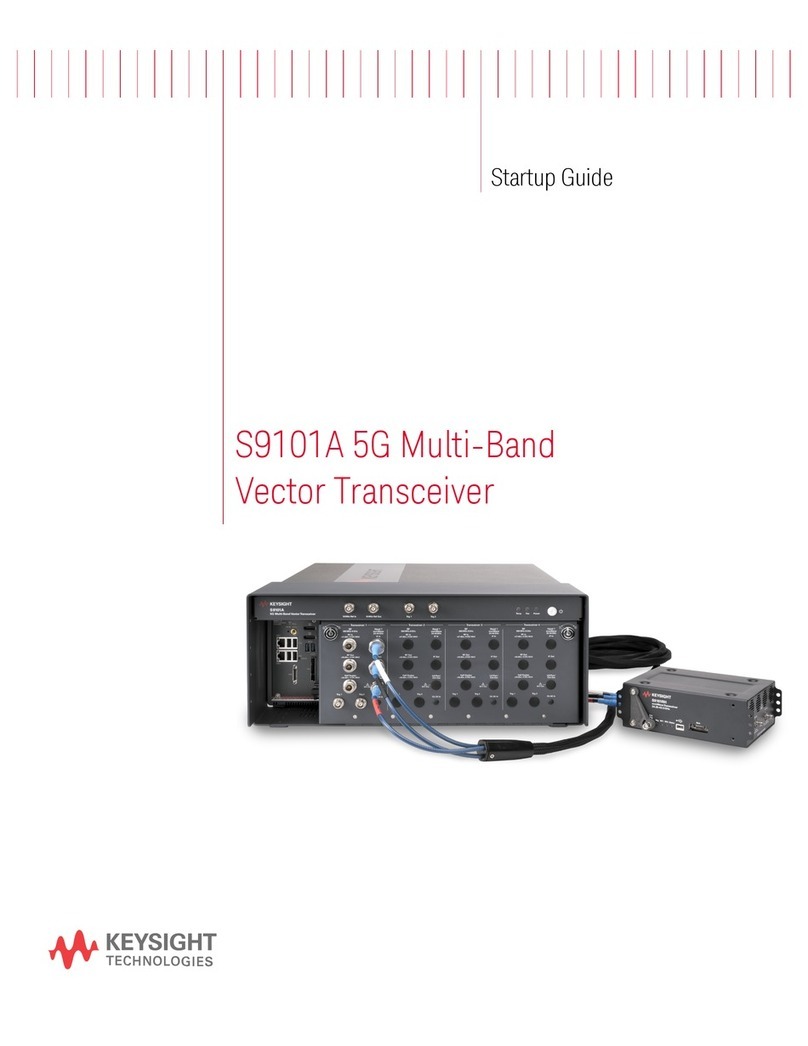
Keysight Technologies
Keysight Technologies S9101A User guide
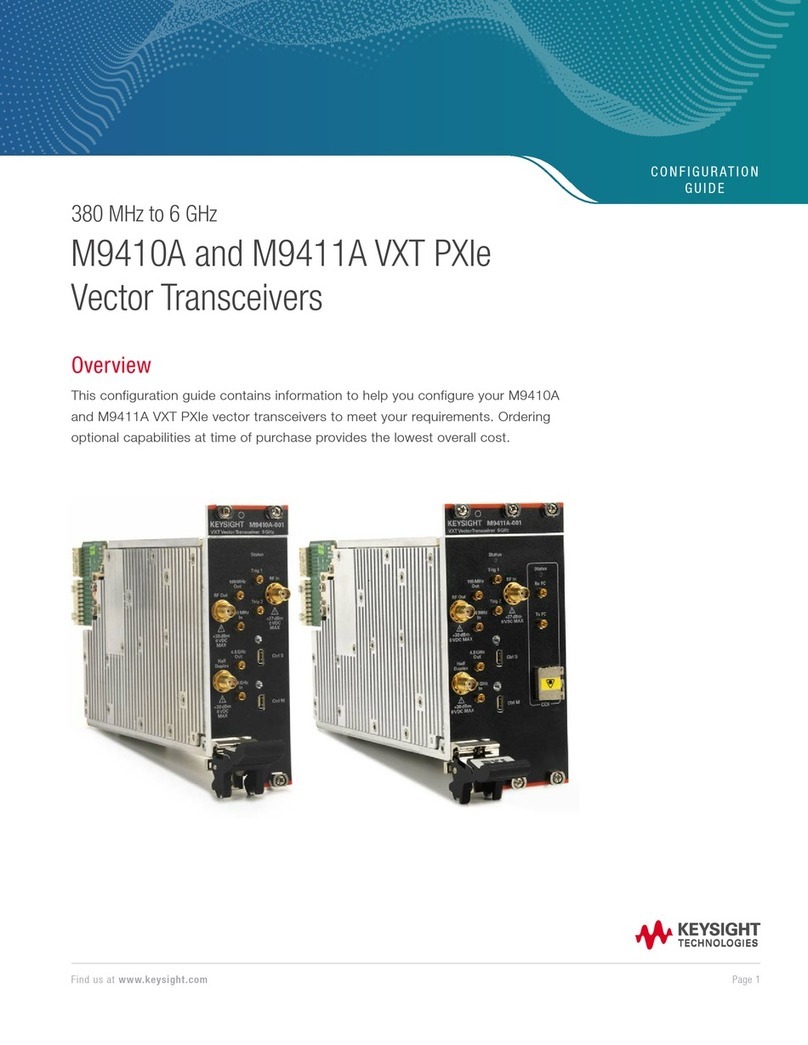
Keysight Technologies
Keysight Technologies M9410A User manual
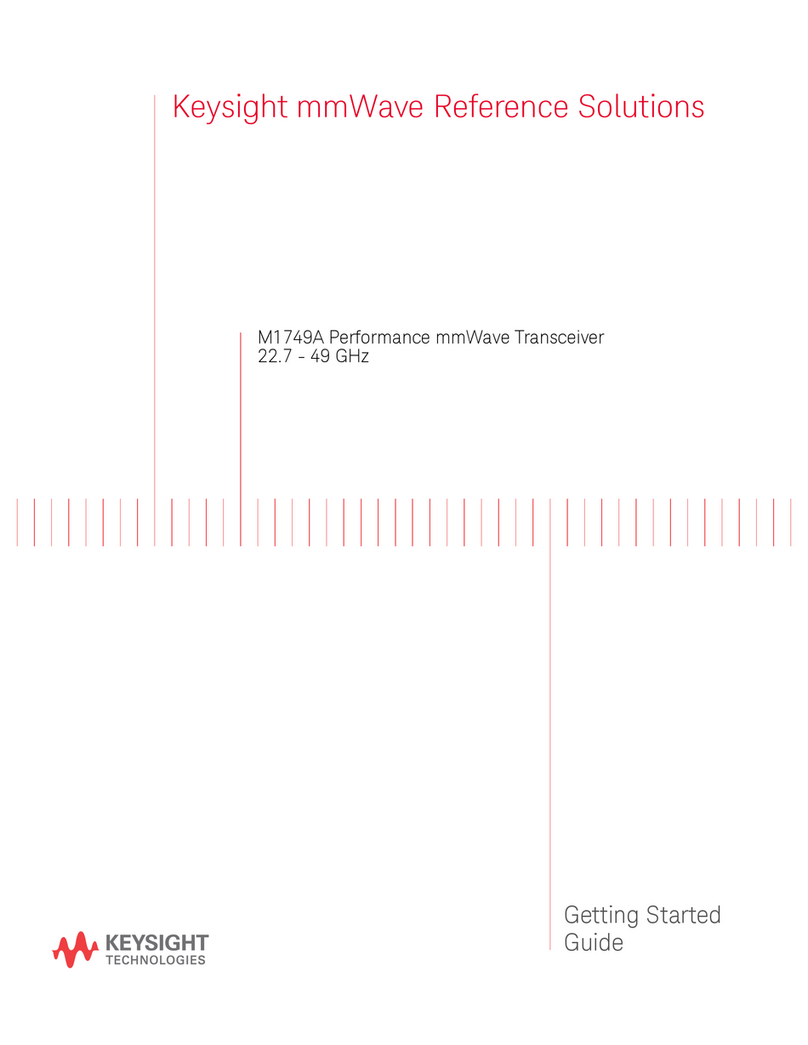
Keysight Technologies
Keysight Technologies M1749A User manual

Keysight Technologies
Keysight Technologies S9101A User guide
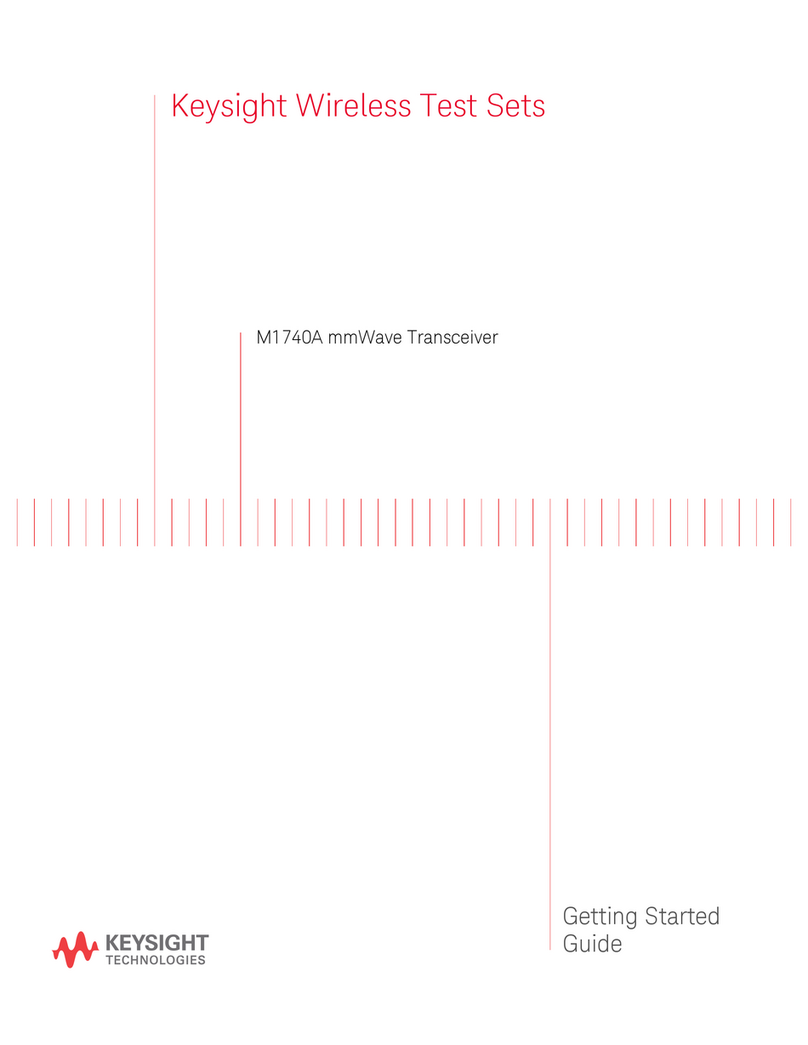
Keysight Technologies
Keysight Technologies M1740A User manual

Keysight Technologies
Keysight Technologies M9420A User manual

Keysight Technologies
Keysight Technologies M1650A User manual
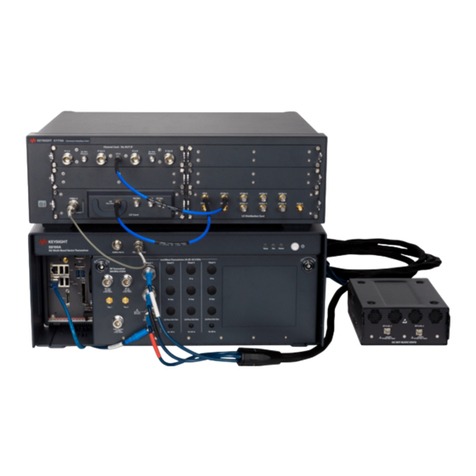
Keysight Technologies
Keysight Technologies S9100A User guide

Keysight Technologies
Keysight Technologies Keysight VXT PXIe Series User manual
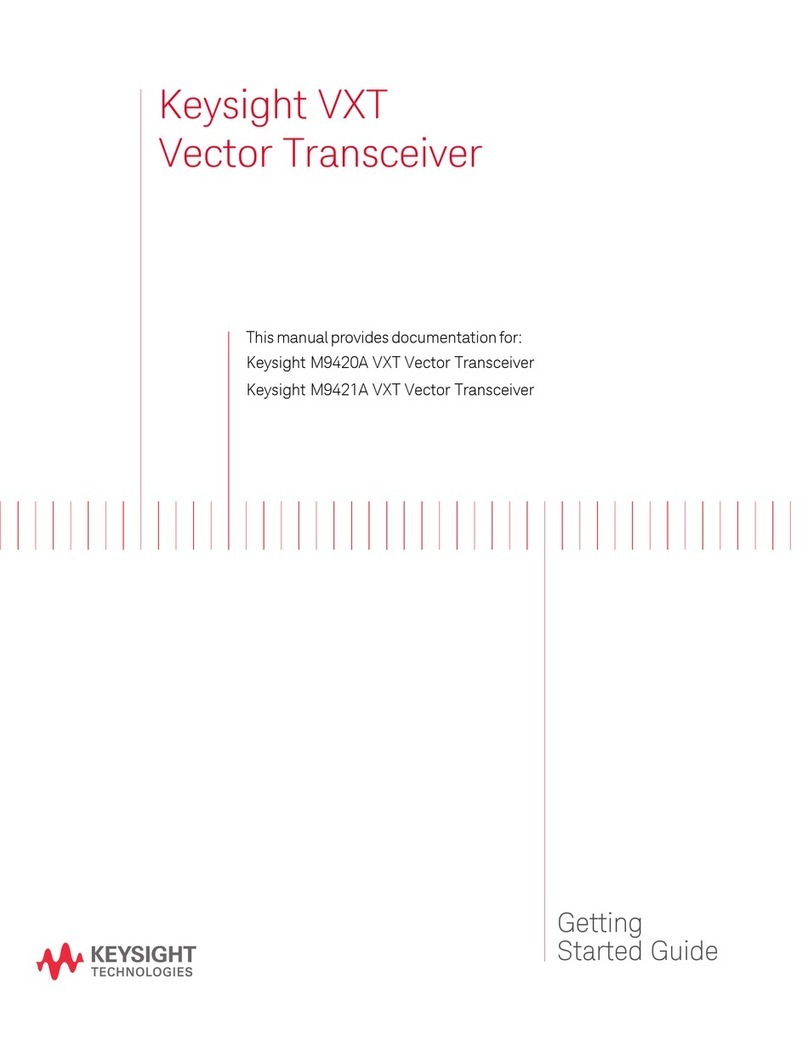
Keysight Technologies
Keysight Technologies M9420A User manual
